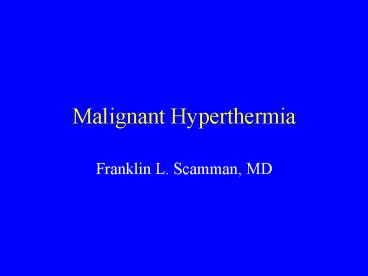Malignant Hyperthermia - PowerPoint PPT Presentation
1 / 23
Title:
Malignant Hyperthermia
Description:
Torpy, Lynm and Glass: JAMA 293:2958, 2005, the ... 1961 Proband family identified in ... Temperature increase is a late sign. Increased end-tidal CO2 is an ... – PowerPoint PPT presentation
Number of Views:1746
Avg rating:3.0/5.0
Title: Malignant Hyperthermia
1
Malignant Hyperthermia
- Franklin L. Scamman, MD
2
References
- Litman and Rosenberg JAMA 2932918, 2005, the
June 15 issue - Torpy, Lynm and Glass JAMA 2932958, 2005, the
patient page - http//www.mhaus.org the web site of the
Malignant Hyperthermia Association of the US.
3
History of MH
- 1961 Proband family identified in Australia
- 1971 First international symposium on MH
caffeine-halothane contracture test developed - 1970s Relation of masseter muscle rigidity to MH
realized - 1975 Dantrolene treatment of MH
4
History of MH
- 1979 FDA approves dantrolene
- 1982 National society formed establishing the MH
hotline - 1980s End tidal CO2 identified as an early sign
- 1990s Ryanodine receptor identified
- 2000 Genetic testing
5
Characteristics of MH
- Sustained, significant hypermetabolism
- Inherited component autosomal dominant
- Abnormal handling of intracellular calcium levels
- Triggered by pharmacologic agents, possibly by
heat/exercise
6
Triggering Agents for MH
- Trigger agents
- Halothane
- Sevoflurane
- Isoflurane
- Desflurane
- Succinylcholine
- Non-trigger agents
- Opioids
- Non-depolarizing muscle relaxants
- Ketamine
- Propofol
- Anxiolytics
- Nitrous oxide
7
Current Concepts of MH
- Muscle rigidity may not be present
- Temperature increase is a late sign
- Increased end-tidal CO2 is an early sign
- MH may occur at any point during an anesthetic
even on emergence and in PACU - May reoccur despite treatment
8
Signs of MH
- Specific
- Muscle rigidity
- Increased CO2 production
- Rhabdomyolysis
- Marked temperature elevation
- Non-specific
- Tachycardia
- Tachypnea
- Acidosis
- Hyperkalemia
9
Masseter Rigidity
- May occur after succinylcholine
- More common in children
- Presages MH in 20-50
- Generalized rigidity not always present
- When present, generally associated with MH
susceptibility
10
Masseter Rigidity
- Incidence in children
- Halothane/succinylcholine 0.5-1
- Halothane/STP/succinylcholine 0.5
- Overall 0.008
- Males 3X over females
11
Masseter Rigidity Treatment
- Stop inhalation agents/succinylcholine
- Continue with non-trigger agents
- Follow end-tidal CO2
- Observe in ICU for 24 hours
- Monitor potassium, myoglobin, CPK
- Dantrolene as needed
- Recommend Bx or genetic studies
12
Masseter Rigidity Treatment
- OR awaken patient
- Observe in ICU for 24 hours
- Monitor potassium, myoglobin, CPK
- Dantrolene as needed
- Recommend Bx or genetic studies
13
Muscular Dystrophies
- Duchennes
- Beckers
- Evans
- Central core disease
- Exercise-induced rhabdomyolysis
- Hypokalemic periodic paralysis
- NOT neuroleptic malignant syndrome
14
Diagnosis of MH
- Halothane/caffeine contracture test using muscle
biopsy the gold standard - 6,000 not covered by insurance
- Must go to the center
- Genetics looking for mutation of RYR-1 receptor
hits only 30 of MH positive so far
15
Muscle Biopsy Centers
- Bethesda
- Chicago
- Los Angeles
- Minneapolis
- Philadelphia
- Rochester
- Sacramento
- Winston-Salem
16
Incidence of MH
- One in 20,000 50,000 anesthetics, depending on
drugs and location - One in 2,000 3,000 based on genetic testing
- Low penetration
17
Immediate Therapy of MH
- Discontinue triggering agents
- Hyperventilate with oxygen
- Get help
- Dantrolene 2.5 mg/kg push. Must dilute 20 mg
bottle with 60 ml DW. Continue for 24-48 hours - Cool patient PRN
- Do not give calcium channel blockers
- Labs as necessary for K, myoglobin
18
Prevention of MH
- Get Hx of MH susceptibility, muscle diseases,
family anesthesia problems - CO2 and temperature monitoring during anesthesia
- Recognition of masseter rigidity
- Investigation of unexplained tachycardia,
hypercarbia and hyperthermia
19
Prevention of MH
- Use succinylcholine only when indicated
- Avoid triggering agents in MH susceptible
patients - Have dantrolene available in any location using
general anesthesia
20
Preparation for MH Susceptible
- Disable vaporizers
- Flush system for 20 min with 10 l/min oxygen
change CO2 absorber - Hide succinylcholine
- Use non-triggering anesthesia agents
- Have dantrolene available
21
Anesthesia for MH Proven
- Anxiolytic
- Propofol-narcotic induction
- Non-depolarizing muscle relaxant
- Maintenance with nitrous-narcotic-propofol-relaxan
t technique - Reversal of muscle relaxant
- Observe for 4 hours
22
North American MH Hotline
- Emergency 1-800-MH-HYPER 24/7
- Routine 1-800-98-MHAUS
- Registry 1-888-274-7899
- http//www.mhaus.org
- http//www.mhreg.org
23
Future Developments
- Additional work on genetics and genetic testing
- Better dantrolene (the current formulation is
hard to dissolve) - Better understanding of pathophysiology































